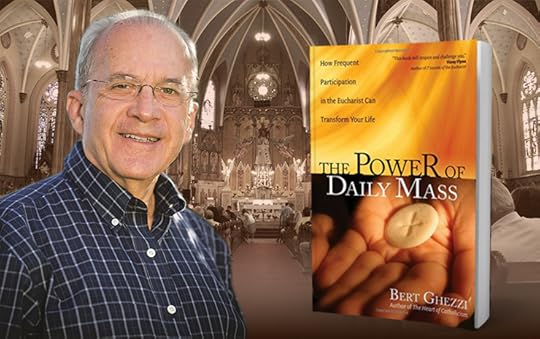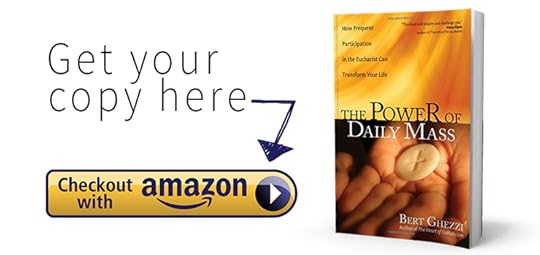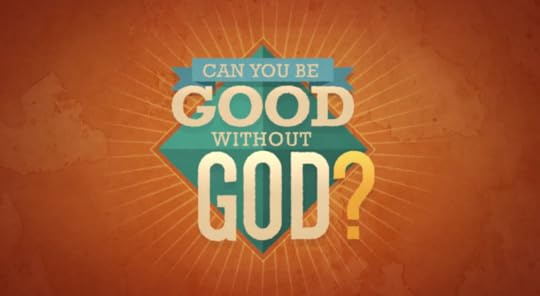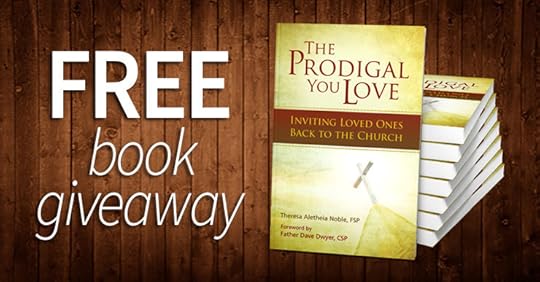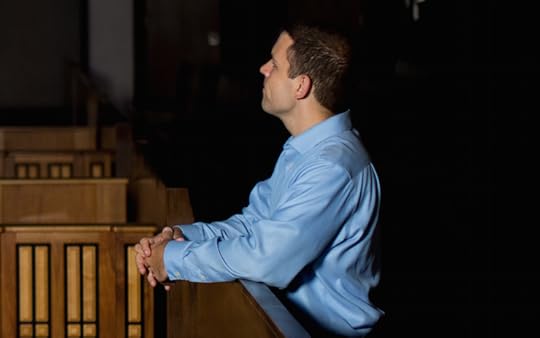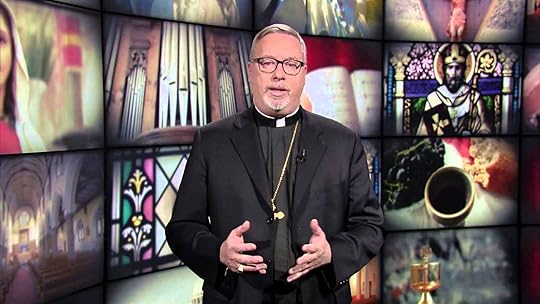Brandon Vogt's Blog, page 19
January 22, 2015
The Power of Daily Mass: An Interview with Bert Ghezzi
After I became Catholic six years ago, my wife and I moved to Orlando and joined our current parish. It was there I met Bert Ghezzi, and we quickly hit off. He wrote books, I read books. He had a large family, we wanted a large family. He was holy, kind, and prayerful, all traits I wanted myself. But one thing especially struck me: Bert attended Mass every day. Each morning, at 7:00am, you could invariably find him praying in his usual pew.
Bert eventually became one of my best friends (and the godfather of our daughter, Teresa.) Over the years, I’ve learned so much from him about prayer, discernment, the saints, and more. But his practice of daily Mass has been perhaps his most significant lesson. We now join him at Mass every day and it’s been incredibly fruitful. In fact, it’s not a stretch to say that committing to daily Mass has been the best decision we’ve made as a family.
Just this week, Bert released his newest book and it’s on this very topic. It’s titled The Power of Daily Mass: How Frequent Participation in the Eucharist Can Transform Your Life (Ave Maria Press). Bert graciously agreed to sit down with me and answer a few questions about it.
BRANDON: In your new book, The Power of Daily Mass, you share how attending daily Mass, consistently for years, has dramatically shaped your life. What benefits have flowed from this commitment?
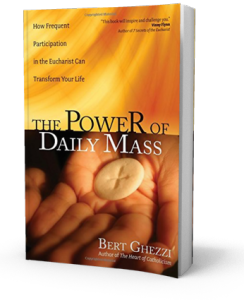 BERT GHEZZI: Meeting Jesus in the Liturgy of the Word and receiving him in the Eucharist has helped me to acknowledge his presence and live close to him daily. I know that the Lord wants to communicate with me, so I listen carefully to the readings and prayers for his words for me.. I reflect on what I hear him say during my prayer times and act on his leadings. Lately, for example, I have been thanking him for his life-long kindnesses to me as I heard him remind me that he has never “withheld his tendernesses.” But the main benefit for me has been the privilege of giving myself to him at the Offertory, which I regard as a renewal of my decision to follow him. I especially value the mind-blowing privilege of offering his eternal sacrifice with him at the Eucharist. And receiving him in my heart at communion, so that I can be a Christ-bearer to my family, friends, and people I encounter.
BERT GHEZZI: Meeting Jesus in the Liturgy of the Word and receiving him in the Eucharist has helped me to acknowledge his presence and live close to him daily. I know that the Lord wants to communicate with me, so I listen carefully to the readings and prayers for his words for me.. I reflect on what I hear him say during my prayer times and act on his leadings. Lately, for example, I have been thanking him for his life-long kindnesses to me as I heard him remind me that he has never “withheld his tendernesses.” But the main benefit for me has been the privilege of giving myself to him at the Offertory, which I regard as a renewal of my decision to follow him. I especially value the mind-blowing privilege of offering his eternal sacrifice with him at the Eucharist. And receiving him in my heart at communion, so that I can be a Christ-bearer to my family, friends, and people I encounter.
BRANDON: The more you attend Mass, the easier it is to sink into empty repetition. How do you avoid this danger and remain attentive and active?
BERT GHEZZI: The repetitive structure of the liturgy far from being a danger gives me a form for spontaneous and heartfelt prayer. From the opening prayer to the dismissal, each familiar movement of the Mass presents an opportunity for my uniting with the Lord, the celebrant, and the congregation in fresh acts of worship. So Mass never bores me. After all, the liturgy is a work of Christ—it is his heavenly worship and my privilege to join him.
BRANDON: Besides communing with Jesus at Mass, you also mention the connection to the saints and their liturgical feast days. How do those impact your spiritual life?
BERT GHEZZI: I have been a saint-watcher for many years. Celebrating their birthdays into heaven at daily liturgies draws me closer to them and they draw me nearer to the Lord. On feast days I often remember something about the saint that encourages me. For example, today the liturgy honored St. Basil the Great, a theologian and apologist who personally served the sick and the poor. He inspires me to look for ways to put my faith into action.
BRANDON: In the book you explain how daily Mass offers a special opportunity to receive forgiveness for sins. How does this happen and why does it hold such spiritual value?
BERT GHEZZI: Every day we commit many little sins. Mine tend to flow from me like water from a faucet. And wonderfully, Mass offers us the Lord’s generous forgiveness in several ways. At the very beginning of the liturgy, we prepare to worship by repenting of our sins. But more significantly, the Liturgy of the Eucharist cleanses us of our venial sins. That’s because the Mass re-presents Jesus’ eternal sacrifice which destroyed our sin and death. (But while the Eucharist strengthens us to resist serious sin, it does not deal with mortal sins, which we must confess in the sacrament of reconciliation.)
BRANDON: Many older Catholics born before Vatican II might be skeptical of daily Mass or frequent communion. How would you respond to criticisms that attending daily Mass is just “too much” or “overly pious”, or that it treats the liturgy too flippantly?
BERT GHEZZI: Some pre-Vatican II Catholics may fit in this category, but I have never met one in the three parishes I belonged to in the past 50 years. And most of the people I worship with at daily Mass like me are over 70 years old. But if I met someone skeptical of daily Mass for the stated reasons, I would explain the privileges and benefits of daily worship (for example, offering with Christ his eternal sacrifice and receiving him in the Eucharist); I would ask one of my daily Mass friends to share their experience with him; and I’d ask him to read my book and discuss it with me.
BRANDON: What advice would you offer those who are intrigued by the idea daily Mass, but who doubt they can commit to regular attendance? How can they ease into it?
BERT GHEZZI: Many Catholics have family and work commitments that prevent them from attending daily Mass. I would encourage them to begin attending Mass one day a week by rearranging their morning commitments. One of my friends, for example, worships on Wednesdays at 7 when he does not need to be at work until 8. Maybe for some their parish schedules weekday Masses at times inconvenient for them. I would encourage them to look for a nearby parish that may offer a noon Mass that they might be able attend. But many people could go to daily Mass but don’t, possibly because they do not realize the benefits. I would encourage them to decide to attend daily for a season like Advent or Lent. For example, I have a friend who decided decades ago to worship at daily Mass for Lent and has never stopped.
The post The Power of Daily Mass: An Interview with Bert Ghezzi appeared first on Brandon Vogt.




Get your FREE copy of “Persuasive Pro-Life”!
Some REALLY exciting news on this otherwise sobering day:
Today, January 22, 2015, marks the 42nd anniversary of Roe v. Wade, the Supreme Court decision which legalized abortion throughout the United States. In an effort to combat abortion and spread the gospel of life, Catholic Answers is offering Trent Horn’s tremendous new book, Persuasive Pro Life: How to Talk About Our Culture’s Toughest Issue, as a completely FREE download.
Those who follow Trent’s work, or who have seen this book, know that it’s simply the best book out there on pro-life apologetics. If you want to become more confident and effective at defending the dignity of life, this is definitely the book you want.
This free offer is exclusively for the Amazon Kindle version of the book, and ends on midnight, January 24. Just click here to download your FREE copy!
NOTE: You do not have to own a Kindle device to read this free book. You can instantly begin reading the book online through Amazon’s Kindle Cloud Reader, or download their free Kindle apps onto your computer, phone, or tablet.
The post Get your FREE copy of “Persuasive Pro-Life”! appeared first on Brandon Vogt.




January 21, 2015
Can You Be Good Without God? [Video]
I’ve written before about William Lane Craig, whom I consider the sharpest Christian apologist today, especially when engaging atheists and agnostics. The Evangelical philosopher travels around the country giving workshops and lectures. He’s probably best known for his public debates with well-known skeptics. (You can watch many of them on his excellent Reasonable Faith website.)
Craig previously released a short video explaining the kalam cosmological argument for God. But just today, he and his team released a new video, this one on the moral argument for God’s existence. In the video, he makes a very important distinction. The moral argument doesn’t claim people need to believe in God to be good (which is why our atheist friends and family members can live morally praiseworthy lives, as many do.) However, they cannot be objectively good without God himself existing.
Craig has often said that the moral argument he outlines in the video resonates with non-Christians more than any other argument he presents. This is because most people recognize that certain acts, like torturing babies for fun or murdering innocent people, are objectively wrong—that is, they are wrong for all people at all times, regardless of human opinion or whether the culture recognizes them as wrong. However, if there is such a thing as objective morality, we must ask, where does it come from? On what is it grounded? These sorts of questions ultimately lead to an objective source of morality, which transcends culture, subjective opinion, and the physical world, a moral ground which theists call “God”.
Enjoy the well-produced video and be sure to share it with skeptical friends and family members:
If you can’t see this video in your RSS reader or email, then click here.
PS. One of the atheists quoted in video is Michael Ruse, a philosophy professor at Florida State University, my alma mater. Michael is probably my favorite atheist writer and I recently interviewed him at StrangeNotions.com about atheism, philosophy, and science.
The post Can You Be Good Without God? [Video] appeared first on Brandon Vogt.




January 16, 2015
“The Prodigal You Love” Book Giveaway!
“Find out how much God has given you and from it take what you need; the remainder is needed by others.” – St. Augustine
Since I’ve built up a large collection of extra books and resources, every week I give some away absolutely free, no strings attached. Each giveaway lasts seven days with a new one beginning every Friday. You can enter any time during the week. Check out my past giveaways here.
Today I’m giving away THREE signed copies of Sr. Theresa Noble’s new book, titled The Prodigal You Love: Inviting Loved Ones Back to the Church.
The Prodigal You Love: Inviting Loved Ones Back to the Church
by Sr. Theresa Noble
Pauline Books and Media, 191 pages, paperback
 When someone you love leaves the Catholic Church, they need a great deal of prayer and love. However, approaching that person with the charity that they deserve and need can be confusing. Sr. Theresa Noble, a former fallen-away Catholic, gently voices ways to talk with and love those who have fallen away.
When someone you love leaves the Catholic Church, they need a great deal of prayer and love. However, approaching that person with the charity that they deserve and need can be confusing. Sr. Theresa Noble, a former fallen-away Catholic, gently voices ways to talk with and love those who have fallen away.
Starting with her story, Sr. Theresa covers the necessary parts of talking with those who have left the Church, told through the lens of the Parable of the Prodigal Son. She addresses the virtues and traits of the father, and how they should apply to approaching those you love. With gentleness, she encourages you to approach them where they are, while emphasizing the importance of the faith.
Above all, she reminds you that God loves your Prodigal even more than you do. With her gentle encouragement, she will lead you to continue to hope for their conversion, so that you might share the joy of the Father when The Prodigal You Love returns home.
I’m using Rafflecopter to help with the giveaway, which is cool because it allows you multiple entries for commenting, posting on Facebook, sharing on Twitter, etc. Click below to enter:
(If you’re reading this through email or RSS and don’t see the giveaway widget, click here.)
By entering this giveaway you agree to occasionally receive email updates from me—no spam, just updates about free books, cool links, and exciting news.
The winner(s) will be randomly selected next Friday and the books will be sent out, free of charge, shortly thereafter.
In the future I’ll be giving away more books and resources, sometimes multiple items per giveaway! So subscribe via feed reader or email to ensure you never miss your chance to win.
(Since I’m covering the shipping costs, only residents within the continental United States are eligible to win.)
The post “The Prodigal You Love” Book Giveaway! appeared first on Brandon Vogt.




January 14, 2015
Dr. Peter Kreeft, Beat Poet
Enjoy Dr. Peter Kreeft pontificating on Truth, Goodness, and Beauty like you’ve never heard him before—with a jazz-infused, hip-hop accompaniment:
If you can’t see this video in your RSS reader or email, then click here.
This mash-up was assembled using portions of Dr. Kreeft’s 2014 Acton University address Good, True, and Beautiful: CS Lewis.
(HT: Even Koons)
The post Dr. Peter Kreeft, Beat Poet appeared first on Brandon Vogt.




January 12, 2015
How I Pray: A Peek Into My Prayer Routine
My friend Tom McDonald, who blogs over at God and the Machine at Patheos, recently interviewed me for his series on how people pray. Read a part of the interview below and then click over to Tom’s site for the rest. Enjoy!
Who are you?
In order of importance, I’m a Catholic, a husband, a father, the Content Director for Fr. Barron’s Word on Fire, and a dabbler in writing, blogging, and speaking. I hope to be a saint.
What is your vocation?
Thérèse discovered it before I did: “My vocation is love!” And more specifically, to love my family. I’m convinced the first two questions God will ask at my judgment are how well I loved my wife and how well I loved my children.
What is your prayer routine for an average day?
It’s changed many times over the years. I used to wake up early–between 4:00am and 5:00am–to pray and read Scripture for half an hour. But I just can’t do that any more. I don’t know if it’s because of kids, because of staying up later with my wife, or just because I’m getting older. But whenever I try to pray in the early mornings now, I can’t focus and usually drift asleep. So here is my typical schedule today:
7:00am-7:30am – Mass with family - We’ve been attending Mass together everyday for the last five years. The Mass is the beating heart of our prayer, the “source and summit’ not just of our Faith but of our devotional life. My wife and I agree that if we fail at everything else during the day but get our family to Mass, our day is a success.
7:40am-7:50am – Personal prayer after Mass – After I help my wife and kids into their car, I head back to the chapel and pray for 5-10 minutes, running over the day’s tasks and asking for the Lord’s help. This is often hit-and-miss–I would say I make it 3-4 times per week.
12:00pm-12:05pm – Angelus – I use the Angelus app, which sends a push alert and notification. For me, the Angelus offers a five minute break during the day to stop, join with others, and focus on the Lord. It’s both the shortest and most difficult part of my routine, which I’ll explain in a moment.
3:00pm-3:20pm – Prayer break and study – At the Word on Fire office in Chicago, they celebrate Mass every day. Since I work remotely, though, I try to take a 20 minute break each afternoon to read and reflect. I usually focus on the saint of the day. This year, I’m working through the entire revised version of Butler’s Lives of the Saints, reading all the entries for each day.
6:30pm-6:45pm – Rosary with family – We started slow with this routine, praying only three Hail Marys per night. After a few months, we moved to a decade. Then a few months later, two decades. We’re up to three decades now, which we’re really happy with, considering our four kids five and under. Each of our older children takes a turn leading a decade.
7:00pm-7:10pm – Prayer with wife – My wife and I just added this to our routine after noticing that neither of us were finding regular quiet time for uninterrupted, personal prayer. We decided the first thing we would do after putting our children down for bed is spend 10 minutes in silence, praying or reading Scripture. We’re only a week in, but so far it’s been a huge help.
How well do you achieve it, and how do you handle those moments when you don’t?
After I became Catholic in 2008, I was pretty scrupulous about keeping my routine. I came from a Protestant culture that supremely valued the “daily quiet time with Jesus.” You miss that, and you’ve missed the core of Christian life. But as the years have passed, I’ve given myself much more grace in the face of life’s vagaries.
I’m still committed to my routine, but when I fail I don’t get discouraged. I understand that the needs of my wife, or children, or work often trump the routine. A figure who understood this well was St. Frances of Rome, one of our few married saints. I spent a while researching her for my book, Saints and Social Justice, and included this quote: “Sometimes a wife must leave God at the altar to find Him in her housekeeping.”
The same can be said of our prayer routines. The routines are simply means to an end: to commune with God. We can achieve that end through many means. Sometimes God uses our routine, sometimes other ways. But I’m no longer a rigorist about my routine.
Read the rest of the interview here!
(Photo credit: Joe Garcia)
The post How I Pray: A Peek Into My Prayer Routine appeared first on Brandon Vogt.




January 6, 2015
The Grace-Filled Poem That G.K. Chesterton and J.R.R. Tolkien Loved
One of the first texts I read after becoming Catholic was Francis Thompson’s “The Hound of Heaven”. It’s a short poem, but a deeply moving one. It vividly describes how God (the Hound of Heaven) chases down a wayward soul, never giving up the pursuit, “down the nights and down the days…down the labyrinthine ways.”
G.K. Chesterton called it the greatest poem in modern English. He described it as a “many-coloured pageant of images and words” that had “the power of Dante”:
The awakening of the Domini canes, the Dogs of God, meant that the hunt was up once more; the hunt for the souls of men; and that religion of that realistic sort was anything but dead . . . . and that the hunt will continue until the world turns to bay.
J.R.R. Tolkien read it a few years before it was published in 1917, and said the poem was “one of the most profound expressions of mature spiritual experience.” He also revealed it had a significant influence on his own writing. (Lord of the Rings fans will recognize the rhythms and cadences from his songs of Middle-earth.)
Emblem Media, a film production team, has prepared a new documentary on the life of Francis Thompson, the man behind the poem:
The Hound of Heaven: The Story of Francis Thompson is a compelling documentary that tells the human story behind the poem. This biography follows the journey of a young man who plummeted from the heights of a comfortable life to the depths of drug addiction in London’s seedy alleys…and then found redemption. In the midst of this painful experience, he wrote what many consider to be one of the greatest poems in Christendom. G. K. Chesterton and J. R. R. Tolkien were among those who wrote of his poetic talent, as well as his influence on their own writing.
You can buy the DVD documentary here for $12.95.
Watch the trailer below, and then take a few minutes to slowly read the poem. Sense the passionate pursuit of grace:
If you can’t see this video in your RSS reader or email, then click here.
The Hound of Heaven
I fled Him, down the nights and down the days;
I fled Him, down the arches of the years;
I fled Him, down the labyrinthine ways
Of my own mind; and in the midst of tears
I hid from Him, and under running laughter.
Up vistaed hopes I sped;
And shot, precipitated,
Adown Titanic glooms of chasmed fears,
From those strong Feet that followed, followed after.
But with unhurrying chase,
And unperturbèd pace,
Deliberate speed, majestic instancy,
They beat—and a Voice beat
More instant than the Feet—
‘All things betray thee, who betrayest Me’.
I pleaded, outlaw-wise,
By many a hearted casement, curtained red,
Trellised with intertwining charities;
(For, though I knew His love Who followed,
Yet was I sore adread
Lest, having Him, I must have naught beside.)
But, if one little casement parted wide,
The gust of His approach would clash it to:
Fear wist not to evade, as Love wist to pursue.
Across the margent of the world I fled,
And troubled the gold gateway of the stars,
Smiting for shelter on their clanged bars;
Fretted to dulcet jars
And silvern chatter the pale ports o’ the moon.
I said to Dawn: Be sudden—to Eve: Be soon;
With thy young skiey blossom heap me over
From this tremendous Lover—
Float thy vague veil about me, lest He see!
I tempted all His servitors, but to find
My own betrayal in their constancy,
In faith to Him their fickleness to me,
Their traitorous trueness, and their loyal deceit.
To all swift things for swiftness did I sue;
Clung to the whistling mane of every wind.
But whether they swept, smoothly fleet,
The long savannahs of the blue;
Or, whether, Thunder-driven,
They clanged his chariot ‘thwart a heaven,
Plashy with flying lightnings round the spurn o’ their feet:—
Fear wist not to evade as Love wist to pursue.
Still with unhurrying chase,
And unperturbed pace,
Deliberate speed, majestic instancy,
Came on the following Feet,
And a Voice above their beat—
‘Naught shelters thee, who wilt not shelter Me.’
I sought no more after that which I strayed
In face of man or maid;
But still within the little children’s eyes
Seems something, something that replies,
They at least are for me, surely for me!
I turned me to them very wistfully;
But just as their young eyes grew sudden fair
With dawning answers there,
Their angel plucked them from me by the hair.
Come then, ye other children, Nature’s—share
With me’ (said I) ‘your delicate fellowship;
Let me greet you lip to lip,
Let me twine with you caresses,
Wantoning
With our Lady-Mother’s vagrant tresses,
Banqueting
With her in her wind-walled palace,
Underneath her azured dais,
Quaffing, as your taintless way is,
From a chalice
Lucent-weeping out of the dayspring.’
So it was done:
I in their delicate fellowship was one—
Drew the bolt of Nature’s secrecies.
I knew all the swift importings
On the wilful face of skies;
I knew how the clouds arise
Spumèd of the wild sea-snortings;
All that’s born or dies
Rose and drooped with; made them shapers
Of mine own moods, or wailful divine;
With them joyed and was bereaven.
I was heavy with the even,
When she lit her glimmering tapers
Round the day’s dead sanctities.
I laughed in the morning’s eyes.
I triumphed and I saddened with all weather,
Heaven and I wept together,
And its sweet tears were salt with mortal mine:
Against the red throb of its sunset-heart
I laid my own to beat,
And share commingling heat;
But not by that, by that, was eased my human smart.
In vain my tears were wet on Heaven’s grey cheek.
For ah! we know not what each other says,
These things and I; in sound I speak—
Their sound is but their stir, they speak by silences.
Nature, poor stepdame, cannot slake my drouth;
Let her, if she would owe me,
Drop yon blue bosom-veil of sky, and show me
The breasts o’ her tenderness:
Never did any milk of hers once bless
My thirsting mouth.
Nigh and nigh draws the chase,
With unperturbed pace,
Deliberate speed, majestic instancy;
And past those noisèd Feet
A voice comes yet more fleet—
‘Lo! naught contents thee, who content’st not Me.’
Naked I wait Thy love’s uplifted stroke!
My harness piece by piece Thou has hewn from me,
And smitten me to my knee;
I am defenceless utterly.
I slept, methinks, and woke,
And, slowly gazing, find me stripped in sleep.
In the rash lustihead of my young powers,
I shook the pillaring hours
And pulled my life upon me; grimed with smears,
I stand amidst the dust o’ the mounded years—
My mangled youth lies dead beneath the heap.
My days have crackled and gone up in smoke,
Have puffed and burst as sun-starts on a stream.
Yea, faileth now even dream
The dreamer, and the lute the lutanist;
Even the linked fantasies, in whose blossomy twist
I swung the earth a trinket at my wrist,
Are yielding; cords of all too weak account
For earth with heavy griefs so overplussed.
Ah! is Thy love indeed
A weed, albeit an amarinthine weed,
Suffering no flowers except its own to mount?
Ah! must—
Designer infinite!—
Ah! must Thou char the wood ere Thou canst limn with it?
My freshness spent its wavering shower i’ the dust;
And now my heart is as a broken fount,
Wherein tear-drippings stagnate, spilt down ever
From the dank thoughts that shiver
Upon the sighful branches of my mind.
Such is; what is to be?
The pulp so bitter, how shall taste the rind?
I dimly guess what Time in mists confounds;
Yet ever and anon a trumpet sounds
From the hid battlements of Eternity;
Those shaken mists a space unsettle, then
Round the half-glimpsed turrets slowly wash again.
But not ere him who summoneth
I first have seen, enwound
With glooming robes purpureal, cypress-crowned;
His name I know and what his trumpet saith.
Whether man’s heart or life it be which yields
Thee harvest, must Thy harvest-fields
Be dunged with rotten death?
Now of that long pursuit
Comes on at hand the bruit;
That Voice is round me like a bursting sea:
‘And is thy earth so marred,
Shattered in shard on shard?
Lo, all things fly thee, for thou fliest Me!
‘Strange, piteous, futile thing!
Wherefore should any set thee love apart?
Seeing none but I makes much of naught’ (He said),
‘And human love needs human meriting:
How hast thou merited—
Of all man’s clotted clay the dingiest clot?
Alack, thou knowest not
How little worthy of any love thou art!
Whom wilt thou find to love ignoble thee,
Save Me, save only Me?
All which I took from thee I did but take,
Not for thy harms,
But just that thou might’st seek it in My arms.
All which thy child’s mistake
Fancies as lost, I have stored for thee at home:
Rise, clasp My hand, and come!’
Halts by me that footfall:
Is my gloom, after all,
Shade of His hand, outstretched caressingly?
‘Ah, fondest, blindest, weakest,
I am He Whom thou seekest!
Thou dravest love from thee, who dravest Me.’
(Text in public domain, copied from EWTN.com)
The post The Grace-Filled Poem That G.K. Chesterton and J.R.R. Tolkien Loved appeared first on Brandon Vogt.




January 5, 2015
Institute on Religious Life National Meeting [Event]

Excited to be speaking alongside Raymond Cardinal Burke, Mike Aquilina, Dawn Eden, and others at the 2015 Institute on Religious Life National Meeting.
Date:
April 11, 2015
Time:
01:30-2:30 p.m.
Event:
Institute on Religious Life National Meeting
Topic:
Digital Duc in Altum: Using Social Media to Wake Up the World
Sponsor:
Institute on Religious Life
Venue:
University of St. Mary of the Lake
Location:
Mundelein, IL
Public:
Public
Registration:
Click here to register.
More Info:
Click here for more information.
The post Institute on Religious Life National Meeting [Event] appeared first on Brandon Vogt.




December 31, 2014
How to Easily Read the Whole Bible in 2015
As you prepare for the new year, why not commit to reading the entire Bible in 2015? It’s not as hard as you might think.
The Bible contains somewhere around 775,000 words. The average adult reads 250 words per minute. That means if you read the Bible for just 30 minutes per day, you’ll get through the whole thing in a year—three times over! (If you read just 10 minutes a day, you’ll still make it through once.)
But once committing to read the whole Bible, people generally have two questions: which translation should I use, and how should I do it?
Which Translation to Use?
Regarding translations, there’s a few things to keep in mind. First, make sure your Bible is complete. Protestant translations (NIV, ESV, TEV, etc.) do not contain the seven deuterocanonical books that the Catholic Church accepts as Sacred Scripture. You’re going to want those books in your Bible (they’re really good!).
Second, make sure your Bible translation strikes a good balance between precision and readability. For serious study, avoid paraphrase translations (such as The Message). Instead, go with a more literal (i.e., “word for word”) translation that is still easy to read. Here are my personal recommendations, in order. All of them have been officially approved by the Church for personal study:
Revised Standard Version – 2nd Catholic Edition (RSV-2CE) – The top choice for many Catholic Bible scholars. It’s a Church-approved translation and is literal but still very readable.
New American Bible – Revised Edition (NAB-RE) – This is the translation used during the Mass, although it does contain some questionably translated passages and some even worse footnotes. But if you want to sync your reading to the liturgy, this is your best choice.
New Revised Standard Version (NRSV) – Solid translation although it contains “gender inclusive language”, changing “brothers” to “friends” or “brothers and sisters” and removing instances of the divine “He”.
Douay-Rheims Version (DR) – This was the standard Bible for English-speaking Catholics from 1609 until the twentieth century. It’s a trusted version but some readers find it turgid, similar to the King James Version.
There are also Bibles on the market that are specifically designed for a one-year reading plan. For instance, there’s the My Daily Catholic Bible (NAB) which divides all of Scripture into 365 segments, one for each day of the year. It features two small, manageable readings for each day, one from the Old Testament and one from the New Testament, along with an insightful quote from a saint for every day. The best part is that the readings are all grouped together sequentially so you don’t have to flip back and forth each day between the Old and New Testaments.
There’s also the Catholic One Year Bible which uses the Catholic Living Bible translation, a less-then-literal translation but one that many readers find looser and more accessible.
In the end, what matters most is that you find a translation you’ll actually read. If you pick one that is cumbersome or inaccessible, then it doesn’t really matter whether it’s accurate. Your best bet is to sample a few translations online and then choose one you feel most comfortable reading each day.
What’s the Best Plan?
Similar to the translation question, the answer here is whichever plan you’ll follow. Unfortunately, many people make the mistake of starting with Genesis and trying to plow straight through to Revelation, linearly. The problem is that some of the early Old Testament books are meticulous, such as Leviticus and Numbers, and most people get bogged down, wiping out before finishing even half the Old Testament.
What’s a better strategy? To follow a carefully designed reading plan that will take you through the right books, at the right pace. Some of these plans alternate between Old and New Testament readings, while some intersperse the Psalms throughout the year to add variation.
Here are some of my favorite Bible reading plans for Catholics. Choose your Bible, then choose one of the plans below and make 2015 the year you finally finish the whole Bible:
Read the Bible and the Catechism in a Year – This plan, created by the Coming Home Network, is definitely my favorite. Not only does it take you through the whole Bible (the Catholic Bible, including the deutero-canonical books), but it also gets you through the entire Catechism of the Catholic Church. Each day you read about three chapters of Scripture and fifteen paragraphs of the Catechism. You’ll knock out both assignments in about thirty minutes each day.
Dr. Mary Healy’s Read the Bible in a Year Plan – This plan by Dr. Mary Healy, a renowned Catholic biblical scholar, is great because it has you reading excerpts from the Old Testament, Psalms, and New Testament each day. That means when you get to the difficult Old Testament sections, you’ll still have the Psalms and New Testament to balance out your daily reading.
CatholicBibleInAYear.org Reading Plan – This one is similar to Dr. Healy’s plan except it gives you even more variety each day. You’ll read two Old Testament readings, one New Testament reading, and one psalm each day.
My Personal Solution
I mentioned above that I prefer the Revised Standard Version – 2nd Catholic Edition (RSV-2CE) for Scripture study. But I also have a secret weapon: the Verbum Bible software.
I’ve written before about how amazing this is, calling it the most powerful Bible resource ever available. But it also makes it super easy to read the Bible in a year. The new Verbum comes with a built-in plan, right out of the box:
The best part about using Verbum is that the reading plan syncs across all of your devices. So you can read your daily passages on your computer, tablet, phone, or any other mobile device. It’s great for people like me who are constantly on the go and often forget to carry around a paperback Bible. Verbum also syncs your highlights and notes across all devices, so the reading experience is seamless.
The Verbum software can be pretty expensive—the base packages each cost hundreds of dollars—but the cheapest way to get access to the software is by purchasing the Catechism of the Catholic Church Collection. It’s only $49.95 and gives you lifetime access to the powerful Verbum software (the most important resource), along with the Revised Standard Version – Catholic Edition (RSV-CE), the lectionary (the readings used at Mass), the documents of Vatican II and the Council of Trent, and a few other resources. All of those documents can be accessed on the go, on any device you’re using. In my opinion, the cost of this is software is more than worth it if it enables you to finish the Bible in a year.
So those are my tips and advice. Now a question:
Are you going to read the whole Bible in 2015?
Let us know in the comment box!
The post How to Easily Read the Whole Bible in 2015 appeared first on Brandon Vogt.




December 22, 2014
Bishops for the Digital Age
At noon time this morning (6:00am ET), Pope Francis named Bishop Christopher Coyne the new bishop of the Diocese of Burlington, Vermont.
Formerly an auxiliary bishop for the Archdiocese of Indianapolis, Bishop Coyne is probably best known for his media expertise. He was the first blogging priest to be named a bishop back in 2011 and remains one of the most active bishops on Twitter. At November’s meeting of the U.S. Conference of Catholic Bishops, Bishop Coyne was voted chairman-elect of the Committee on Communications.
A few years back I interviewed him about his online ministry:
If you can’t see this video in your RSS reader or email, then click here.
In conjunction with the new appointment, Bishop Coyne unveiled his revamped website at BishopCoyne.org:
It’s a clean and well-designed site built on WordPress, which is the world’s most popular content management system (in part because it’s free and open source.) It’s the kind of simple, effective website every bishop could and should commission.
It seems to me that more and more bishops are realizing the importance of online ministry. The Internet is of course just one component of a healthy and vibrant episcopacy, which should be ultimately grounded in the sacraments and a personal encounter with Christ. But bishops are, fundamentally, teachers. And their teachings stand to affect far more people online than from their pulpits—especially inactive Catholics and those disenchanted by our institutions.
(A close priest friend of mine, an active tweeter, says his Twitter reflections on each day’s Gospel typically reach 10-50 times more people than the number who attend his daily Mass in person. What St. Josemaria Escriva did through The Way and Pascal through his Pensées—planting seeds of the Gospel through short, pithy reflections—more and more priests are doing online. Again, this isn’t to say social media replaces sacraments or homilies, only that it provides an effective route of access to people we would otherwise miss.)
 I continue to admire Bishop Coyne’s online work and will resist adding more praise to the pile. But I do want to note his intriguing decision to shift to a personal domain name (BishopCoyne.org). He could have chosen to house his resources on a diocesan domain (like ArchIndy.org or VermontCatholic.org) or on his previous blog URL (thoughtsofacatholicbishop.blogspot.com). But his move to a personal domain is smart for three reasons.
I continue to admire Bishop Coyne’s online work and will resist adding more praise to the pile. But I do want to note his intriguing decision to shift to a personal domain name (BishopCoyne.org). He could have chosen to house his resources on a diocesan domain (like ArchIndy.org or VermontCatholic.org) or on his previous blog URL (thoughtsofacatholicbishop.blogspot.com). But his move to a personal domain is smart for three reasons.
First, the new domain is simple and easy to remember. Want to follow Bishop Coyne’s reflections or see his thoughts on topic A, B, or C? Just go to BishopCoyne.org. Two words, one simple URL—it’s easy to remember and share. The personal domain will also boost his visibility in the search rankings since, for example, more people will be searching “Bishop Coyne thoughts on marriage” than “Diocese of Burlington thoughts on marriage”. I think every bishop should own and use a domain associated with his name.
Second, using BishopCoyne.org makes his resources more portable. When bishops move from one diocese to another, as happens often, their online resources typically get “stuck” on the former diocese’s page. Even if you copy-and-paste the resources to the new diocese’s website, older links will continue directing to the previous diocesan webpage and your search rankings will be jumbled. It’s a frustrating mess. However, by using a personal domain, Bishop Coyne has attached his resources to his person. They now will move with him wherever he goes, adding continuity to his online ministry.
Third, a personal domain highlights an important ecclesial distinction. It affirms that a bishop’s Petrine teaching authority is rooted in his personal office, not his diocese. It’s not the diocese that teaches and leads, it’s the bishop. The diocese indeed “teaches” but only to the extent that it operates in the name of the bishop. A personal domain elevates this subtle distinction.
For these reasons and more, I strongly encourage more bishops to follow Bishop Coyne’s lead and grow personal, online platforms from which to teach and evangelize (e.g., ArchbishopCupich.org or CardinalDolan.org). This isn’t about creating a cult of personality or subverting our helpful diocesan structures. It’s about amplifying a bishop’s teaching effectiveness and reach.
Bishop Coyne provides a great example of this. When future historians reflect on the American episcopacy, they will point to him as a pioneer who harnessed “new ardor, methods, and expressions” to teach and evangelize.
(I should note that bishops don’t have to do all this themselves. Like Pope Francis and Venerable Fulton Sheen, Bishop Coyne leaned on the expertise of others to create his media platform. He cast the vision and provided the content but they handled the technical details. If you need some help and don’t know where to turn, email me at brandon@brandonvogt.com and I would be happy to point you in the right direction.)
The post Bishops for the Digital Age appeared first on Brandon Vogt.




Brandon Vogt's Blog
- Brandon Vogt's profile
- 75 followers


